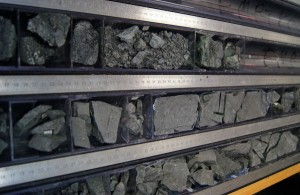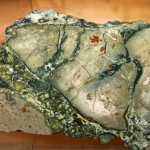29 September 2014
As expedition ends, scientists feel the pressure
Posted by Nanci Bompey
By Amy West
Amy West is the science writer and outreach and education officer for the JOIDES Resolution, a drill ship operated by the International Ocean Discovery Program (IODP) that is on a two-month expedition studying the Izu-Bonin-Mariana Arc in the region where the Pacific Plate is descending under the Philippine Plate to form the Mariana Trench and the deepest point in the ocean–the Challenger Deep. Read more about the expedition here.
The wind whipping around from Tropical Storm Fung-Wong makes it challenging to write outdoors. I know–what kind of complaint is that? But after severely reduced physical activity for eight weeks on this ship, sitting in front of a computer sends the sit bones into spasms. Plus the wind puts the constantly whirring thrusters into overdrive, which keep us on station. That would be fine and all, but I share a cabin with a buzzing bow thruster, so it’s “Sleepless at Sea” for me.
Sunset watch now seems to be busier on “steel beach” (top deck with great views and deck chairs), and finding a place to get away from it all can be harder near the end of an expedition. I’m writing in the wind because a chief scientist nabbed my comfortable writing spot. The shift in energy gears for everyone is most noticeable—people are more edgy. A whiteboard listed names of those on the nightshift who began cracking. It’s challenging to sustain the energy levels exuded at the beginning, since writing reports, analyses, and daily seminars eventually looks like a conveyor belt of never-ending goods. Turns out we all need variety in our day-to-day living; even scientists who love the idea of doing JUST research.
The one constant during these two months is the drilling operations; it never sleeps, and sometimes, it seems, neither do the crew. The complexity of the operations seems like IODP [International Ocean Discovery Program] would rarely encounter success, but with the troubleshooting expertise and finely tuned fashion of collecting data, the program has garnered phenomenal success. Research from IODP and its previous namesakes provided evidence for plate tectonics, ocean temperatures during the Ice Age, microbes that live in the seafloor, and a major meteor that rammed Earth 65 million years ago. These missions can be a lot of “bang for the buck.” Not only does one research cruise provide physical specimens for ANY geoscientist to sample a year after the cruise ends and decades beyond, but it also can spawn many scientific papers, since it requires a herd of scientists to tell this story.

The galley crew goes all out for a sushi night– a great morale booster toward the end of the cruise.
Credit: Amy West
During the cruise, each science faction will present preliminary data about the site we are currently drilling, and then do it again when we leave that hole. Facts, thus, arrive in pieces, much like the fractured rocks we bring up. There’s hardly time to step back, connect the pieces across scientific fields, and discuss the bigger picture because of the continuous flow of rocks that need classification, or mashed into powder for chemical analyses, or heated to 600° C to demagnetize. Each group submits reports each week, each month, and for each site. A year following the cruise only scientists involved in this mission can analyze the material. If they publish anything, ALL the scientists must be listed as author. After a year the moratorium is lifted, and the rest of the rock science world has access to the samples. The original group then meets one to two years later to discuss their findings. And this time they won’t be on a boat.
Though two months feels like oodles of time, in the end it feels like we need more time and data to formulate the cohesive picture of what the rocks say about the origins of subduction; after all we drilled just four sites that averaged 20 percent in rock recovery. Combining results from all three 2014 cruises to the Izu-Bonin-Mariana region will take years. In some cases, an expedition can bring up samples that debunk a geoscientist’s entire life’s work. Each scientist on board will probe in more detail back on land in labs that aren’t bobbing up and down and have more instruments. The staff scientist for this cruise, Katerina Petronotis, and chief scientists Julian Pearce and Mark Reagan, who are the stewards of the entire expedition and ensure each person follows through on their obligations, has an official role on this mission until 2018.
Our group decided to pile on one more writing assignment: submit a scientific paper to a high-level journal within the next two months. Since the National Science Foundation funds this research, preliminary results are released to the public two months after the mission ends. However, if a paper is accepted within this two-month moratorium (which has happened only a few times prior), that public release will be put on hold.
Getting to make such a discovery comes back to having so many things go right. Weather is one of them. We had unbelievably calm weather despite sailing in the heart of typhoon season, whereas Expedition 351 ceased operations to move for weather. Anything beyond 14- to 15-foot heave on the drill string can compromise drilling as it’s hard to keep the bit on the bottom. We were also lucky to escape using explosives to free ourselves from fault material that had buried us; 190,000 pounds of pulling force did the trick so we could retrieve thousands of feet of drill pipe.
Ironically, Tropical Storm Kammuri inches toward the site we just left. As we now head for port in Taiwan, the mood has changed again. Images of beer appear on the walls and in presentations. There’s conversation about walking more than 30 meters without having to climb stairs. No matter how tired we are at the end of the day, or the trip, the opportunity to be on board this drill ship as a scientist, technician or educator is remarkable. The data collected on this trip about subduction zone origins will likely generate new models, and show that our planet is more complicated than previously thought. We’ll have to remember this when returning to the stresses of our normal lives.
Grass is always greener, even when sailing on the blue, blue ocean.

When first beginning this expedition, we (green dot) were safely tucked in between two typhoons. Wind image generated on earth.nullschool.net. Data from GFS / NCEP / US National Weather Service
– Guest blogger Amy West is the science writer and outreach and education officer for the JOIDES Resolution. This post first appeared on National Geographic’s Ocean Views blog, where you can also read additional blog posts about the expedition. Follow the expedition on Twitter.







 GeoSpace is a blog on Earth and space science, managed by AGU’s Public Information staff. The blog features posts by AGU writers and guest contributors on all sorts of relevant science topics, but with a focus on new research and geo and space sciences-related stories that are currently in the news.
GeoSpace is a blog on Earth and space science, managed by AGU’s Public Information staff. The blog features posts by AGU writers and guest contributors on all sorts of relevant science topics, but with a focus on new research and geo and space sciences-related stories that are currently in the news.